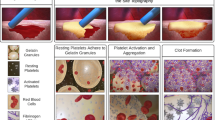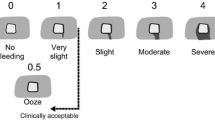Abstract
To compare the difference in efficacy of microcrystalline collagen powder (CL) and fibrin glue (FG) in elective hepatic resection, 62 patients (female 14, male 48) with ages ranging from 51 to 75 years were randomly allocated to receive either CL or FG as a topical agent during hepatectomy. There were no significant differences between the patients treated with CL (n=31) and those treated with FG (n=31) regarding sex, age, liver function, coagulation function, platelet counts, type of liver resection, and operative duration. A dry cut surface of the liver was obtained during surgery in 27 (87%) patients and 25 (81%) patients treated with CL and FG, respectively. Both CL and FG showed similar hemostatic effects. The CL and FG groups were not different in terms of postoperative rebleeding, bile leakage, or morbidity and mortality rates (6% vs. 6%, 6% vs. 6%, 45% vs. 39%, and 13% vs. 10%, respectively). Of the 52 patients with a dry cut surface of the liver during surgery, 3 patients in the CL group encountered rebleeding (n=1) or bile leakage (n=2) from the cut surface postoperatively, while no such complications were noted in the FG group. The results seem to favor FG for reliability in the postoperative period. The application of CL or FG may be better performed with consideration of the characteristics of each agent.
Résumé
Pour comparer les efficacités respectives de la poudre de collagène micocristalline (PCM) et de la colle de fibrine (CF) dans les résections électives du foie, 62 patients (14 femmes, 48 hommes), dont les âges variaient de 51 à 75 ans, ont été randomisés. Ils ont reçu soit la PCM (n=31) soit la CF (n=31) comme agent d'hémostase locale après hépatectomie. Il n'y avait pas de différence significative entre les patients des deux groupes en ce qui concerne le sexe, l'âge, la fonction hépatique, le bilan de coagulation, la numération plaquettaire, le type de résection ou la durée de l'opération. Une section hépatique séche a pu être obtenue en peropératoire dnas 27 (87%) et 25 (81%) cas, respectivement. Les effets hémostatiques des deux agents ont été similaires. Il n'y a pas eu de différence en ce qui concerne l'hémorragie post-opératoire (6% vs 6%), les fuites biliaires (6% vs 6%), la morbidité (45% vs 39%) ou la mortalité (13 vs 10%). Parmi les 52 patients pour lesquels une surface sèche avait été obtenue en peropératoire, un patient a eu une nouvelle hémorragie, et deux ont eu une fuite biliaire dans le groupe PCM, alors qu'aucune de ces complicaitons n'est survenue dans le groups CF. Ces résultats sont en faveur de la CF en ce qui concern la fiabilité des résultats, mais la CF est plus de deux fois plus chère. Le choix entre la CF ou la PCM pourrait dépendre des caractéristiques spécifiques de chaque agent.
Resumen
Con el propósito de comparar la differencia en cuanto a eficacia hemostásica entre el polvo de colágeno microcristalino (CL) y la goma de fibrina (FG) en la resección hepática electiva, 62 pacientes (14 mujeres, 48 hombres) con edades entre 51 y 75 años fueron asignados en forma aleatoria para recibir CL o FG como agente hemostático tópico en el curso de la hepatectomía. No hubo diferencias significativas en cuanto a sexo, edad, función hepática, función de coagulación, recuento de plaquetas, tipo de la resección hepática y duración de la operación entre los pacientes en quienes se utilizó CL (grupo CL, n=31). El CL y la FG exhibieron efectos hemostásicos similares; no se observaron diferencias en cuanto a sangrado postoperatorio, escape biliar, tasas de morbilidad y de mortalidad (6% vs 6%, 6% vs 6%, 45% vs 39% y 13% vs 10%, respectivamente). Entre 52 casos con superficie seca de sección durante la cirugía, a pacientes del grupo CL presentaron resangrado (n=1) o escape biliar (n=2) a partir de la superficie de sección, contra ninguno en el grupo FG. Los resultados parecen estar a favor del FG en relación a la confiabilidad en el período postoperatorio pero debe tenerse en cuenta el elevado costo. La aplicación de CL o FG debe ser realizada en consideración a las características particulares de estos dos agentes.
Similar content being viewed by others
References
Faist, E., Hartl, W., Siskind B., Baker, C.C., Rogers, G., Duray, P., Witte, J., Heberer, G., Baue, A.E.: The use of infrared sapphire contact coagulation and fibrinogen adhesive for hemostasis after partial hepatectomy: A comparative study. In Fibrin Sealant in Operative Medicine, General Surgery and Abdominal Surgery, G. Schlag, H. Redl, editors, Berlin, Springer-Verlag, 1986, pp 72–84.
Giakoustides, E., Drosinopoulos, P., Agouridakis, K., Galanis, N.: Surgical treatment of liver injuries by application by Fibrinkleber. World J. Surg.9:144, 1985
Hauser, C.J.: Hemostasis of solid viscus trauma by intraparenchymal injection of fibrin glue. Arch. Surg.124:291, 1989
Kram, H.B., Nathan, R.C., Stafford, F.J., Fleming, A.W., Shoemaker, W.C.: Fibrin glue achieves hemostasis in patients with coagulation disorders. Arch. Surg.124:385, 1989
Hait, M.R., Robb, C.A., Baxter, C.R., Borgmann, A.R., Tippett, L.O.: Comparative evaluation of avitene microcrystalline collagen hemostat in experimental animal wounds. Am. J. Surg.125:284, 1973
Abbot, M., Austen, G.: The effectiveness and mechanism of collagen induced hemostasis. Surgery78:723, 1975
Lin, T.-Y.: Results in 107 hepatic lobectomies with a preliminary report on the use of a clamp to reduce blood loss. Ann. Surg.177:413, 1973
Nagasue, N., Yukaya, H., Ogawa, Y., Hirose, S., Okita, M.: Segmental and subsegmental resections of the cirrhotic liver under hepatic inflow and outflow occlusion. Br. J. Surg.72:565, 1985
Child, C.G., Turcotte, J.G.: Surgery in portal hypertension. In Major Problems in Clinical Surgery: The Liver and Portal Hypertension, C.G. Child, editor, Philadelphia, W.B. Sauders, 1964, pp. 1–85
Jakob, H., Campbell, C.D., Stemberger, A., Wriedt-Lubbe, I., Blumel, G., Replogle, R.L.: Combined application of heterologous collagen and fibrin sealant for liver injuries. J. Surg. Res.36:571, 1984
Sakon, M., Monden, M., Gotoh, M., Kobayashi, K., Kambayashi, J., Mori, T., Okamura, J.: Use of microcrystalline collagen powder and fibrinogen tissue adhesive for hemostasis and prevention of rebleeding in patients with hepatocellular carcinoma associated with cirrhosis of the liver. Surg. Gynecol. Obstet.168:453, 1989
Author information
Authors and Affiliations
Rights and permissions
About this article
Cite this article
Kohno, H., Nagasue, N., Chang, YC. et al. Comparison of topical hemostatic agents in elective hepatic resection: A clinical prospective randomized trial. World J. Surg. 16, 966–969 (1992). https://doi.org/10.1007/BF02067005
Issue Date:
DOI: https://doi.org/10.1007/BF02067005




